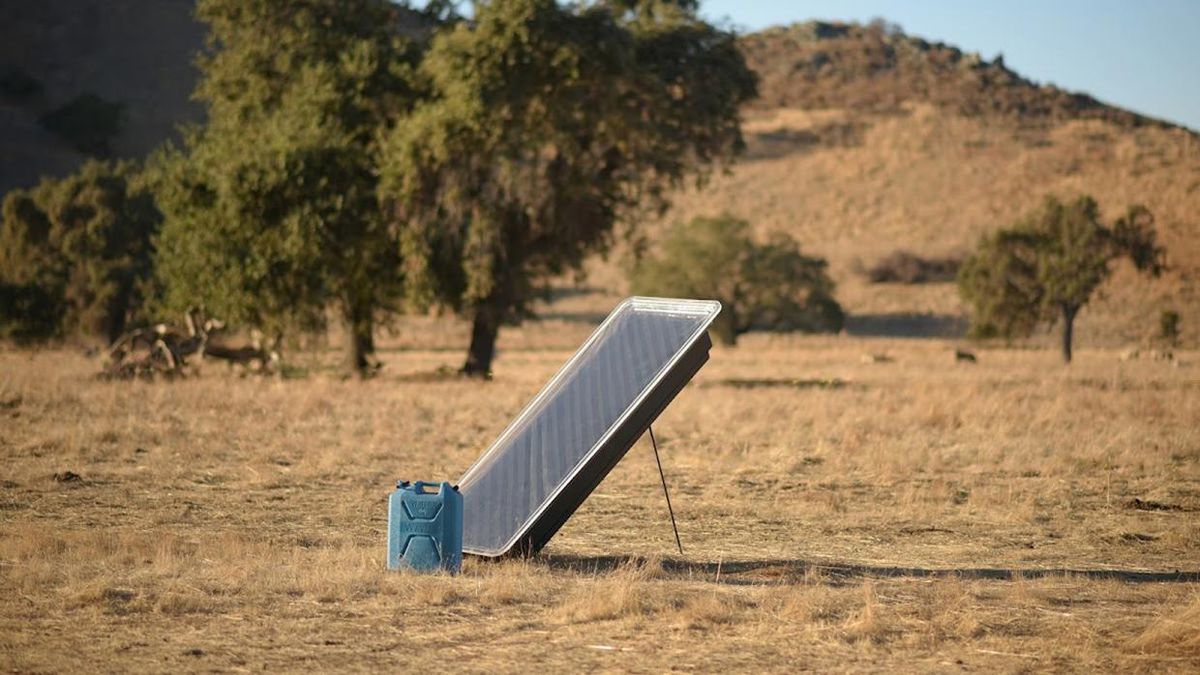One in four people in this world, about 2.2 billion, do not have reliable access to safe drinking water. Small solar-powered devices that pull water out of thin air could help provide potable water for one billion of those, according to a study published recently in Nature.
The new study by researchers at Alphabet, Inc.'s X, The Moonshot Factory (previously Google X) is the first to map the global potential of atmospheric water harvesting (AWH) technology.
"This is exciting because of the unique potential solar-powered atmospheric water harvesting devices have to be off-grid, portable, low-cost, and renewably-powered, putting the power of sourcing drinking water into the hands of individuals," says X engineer Philipp Schmaelzle who led the work with his colleague Jackson Lord.
Desalination and wastewater treatment to produce potable water are being implemented to produce potable water on a large scale in some parts of the world, but these technologies remain expensive for many others that lack the financial resources and required infrastructure.
Atmospheric water harvesters, which capture moisture from the air, would be more accessible. But they have been largely overlooked because, says Schmaelzle, "historically there's been some debate around whether the outputs of atmospheric water harvesters would be high enough to make them a viable solution for a large number of people."
Researchers estimate that AWH could theoretically deliver water extraction yields sufficient to meet basic needs of one billion people.
Groups around the world have designed various types of AWH systems. Passive devices, which typically rely on special fabrics and materials that collect dew or fog, are limited to areas with humidity. Active devices, meanwhile, use sorbent materials to capture water vapor from the air and either use low-temperature solar heat to release the moisture or cool it down to condense the vapor and produce water.
These solar-driven AWH systems can use natural sunlight and generate fresh water in areas with relative humidity as low as 20 percent, which opens up a broader swath of the globe where they could be employed and have an impact.
To estimate the extent of that impact, Schmaelzle and his colleagues created a geospatial tool called AWH-Geo built on the Google Earth Engine platform. The tool uses data from ERA5-Land, a publicly available dataset that provides decades worth of high-resolution, hourly information of evolving land variables.
AWH-Geo looked at three variables to calculate the output of AWH devices: sunlight irradiance, or the solar energy hitting a square meter of land; relative humidity; and air temperature. The researchers used published performance data of various AWH devices to map their maximum theoretical output in different parts of the world.
They then compared the water-production map with WHO/UNICEF maps of the distribution of the 2.2 billion people without access to safe drinking water. Any AWH device will likely produce less water in the real world than its theoretical potential. But the researchers found that a hypothetical one square-meter device that produces 0.2–2.5 liters/kWh could meet the average daily drinking water needs of 5 liters per day of around 1 billion people, assuming that it was irradiated with over 600 W of solar power continually for two to three hours a day to harvest water in relative humidity above 30 percent.
The X team has developed its own prototype AWH that works with help from sorbent materials. The device has a solar heating panel that heats a stream of air pulled in by a fan. An absorbent material helps this hot air stream absorb moisture from a second air stream being pulled in by another fan. The now humid, warm stream of air is then sent to a lower chamber to cool down, prompting the water vapor to condense and collect at the bottom.
In rooftop testing, the device produced 150 millileters of water an hour for each square meter of the device area. That's enough to keep a person hydrated in many dry parts of the world. Further development could lead to a device capable of producing 5 liters per day at a price as low as 1 cent/liter. But that would require more engineering and mass production, which the company says is beyond its vision. Instead, they have made the design free for others to develop further.
Startup SOURCE (formerly Zero Mass Water), which has an impressive list of backers, has a similar device that is already available on the market. But it remains prohibitively expensive at around $6,000 for a two-panel array that produces around 7.5 liters of water per day.
Solar-powered water harvesters that operate on a continuous cycle and use advanced sorbent materials might be more promising and could work well in many regions of the world, the X team's analysis shows. Advanced sorbent materials have some of the highest water outputs. But they are also expensive and will need to be developed further and mass manufactured to reach cost targets.
"Solar-powered atmospheric water harvesting is still an emerging technology," says Schmaelzle, "and is yet to be adopted and implemented on a large scale. We hope [our] paper's findings and tools can help inform the development of future atmospheric water harvesting devices, so that researchers and designers can maximize real world impact."
19 Nov. 2021 Correction: This story was updated to emphasize the geolocation tools Alphabet developed, not any specific atmospheric water harvester devices—which the previous version of this story inaccurately emphasized; 22 Nov. 2021: The story was updated with additional information from X concerning their cost per liter estimates (the previously published 10 cents/liter estimate is, according to X researchers, an estimate and not a rigorous finding) and its condensing cycles (their device does not in fact operate on a cooling-condensing cycle, as was previously reported).
Prachi Patel is a freelance journalist based in Pittsburgh. She writes about energy, biotechnology, materials science, nanotechnology, and computing.



